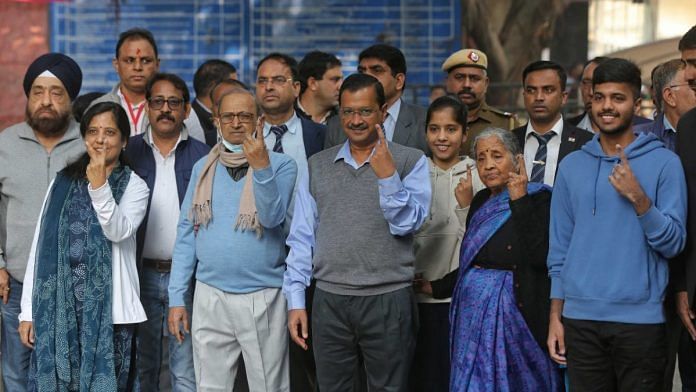Like any other election results in the past, the recent ones in Delhi, Gujarat and Himachal Pradesh evoke mixed reactions and extend lessons for those who wish to learn. It is a washout for the Congress in Delhi but a comeback in Himachal Pradesh. Incidentally, while Rahul Gandhi is busy in Bharat Jodo Yatra making the Congress look like an NGO, the Chairperson of the Congress Parliamentary Party, Sonia Gandhi, did not address a single election rally in any of the states including Himachal Pradesh.
The Aam Aadmi Party (AAP), which trounced the Bharatiya Janata Party (BJP) in the Municipal Corporation of Delhi (MCD) polls, lost deposit in all seats in Himachal Pradesh and was a poor third in Gujarat. The BJP, which broke its own record and overcame anti-incumbency in Gujarat, has lost the prestigious MCD and Himachal Pradesh. The factors that can be attributed to the victory of one party in one state goes against the same party in another state.
BJP’s Himachal story is Bengal tale
No party has been able to retain power in Himachal Pradesh since 1985. The revolving door election result is evident as the BJP lost 18 seats to Congress which the Congress had lost to the BJP five years ago. But the Congress victory and the BJP’s poor show have certain lessons for both parties. Both Congress and the BJP did not have powerful veterans campaigning this time. Former Chief Minister Late Veerbhadra Singh was a charismatic figure whose hold over his community was as good as over others in the state. The BJP too did not see any of the former chief ministers campaign this time.
The leadership of both the parties had limited appeal beyond their area of influence, nor were they pan-state figures popular enough to influence the voters. While both parties had their own share of intra-party rivalry, the BJP had a record number of nearly 21 rebels contesting 68 seats–nine of them emerged victorious. Some of these rebels have seriously eroded the BJP’s vote bank resulting in the defeat of the official candidate by a thin margin.
Interestingly, barely a month before the election, a number of senior Congress leaders and sitting MLAs joined the BJP and some of them were given tickets to contest, angering BJP workers. During the 2021 West Bengal assembly election, a similar trend was witnessed. A large number of Trinamool Congress (TMC) leaders who joined the BJP lost the election. The BJP needs to learn a lesson from this. And its Delhi team needs to be totally revamped and some heads must roll if the party wants to retain all seven seats in Lok Sabha in 2024.
Also read: 3 polls, 3 parties, 3 outcomes: Conclusive yet bittersweet for BJP, AAP & Congress
AAP gets challenger tag
For AAP to be recognised as a national party, it has to win three percent of the assembly seats or get six percent votes and two assembly seats. Alternatively, it needs to get eight percent of the total votes polled in the assembly elections. After winning about 12 percent votes in Gujarat, the AAP is now a national party. So, what will change for the so-called opposition unity now?
After winning Punjab, getting one seat in Goa, winning Delhi assembly and unseating the BJP from Delhi Municipal Corporation which it held for fifteen long years, the AAP is seen as the only party that can effectively challenge the BJP. In many of these elections, the AAP has either dented the Congress vote bank or nibbled into non-BJP-non-Congress parties like the Shiromani Akali Dal (SAD) in Punjab or some of the state-level political outfits in Goa. Will these parties like to share podiums with the AAP and become its electoral allies?
Again, there are parties in the South like the DMK and AIADMK in Tamil Nadu and Janata Dal (Secular) in Karnataka which might consider AAP as a predator rather than a partner in their fight against the BJP and the Congress. The Congress too will think twice before it can enter into an alliance with the AAP in states such as Himachal Pradesh, Madhya Pradesh, Rajasthan, Chhattisgarh and Uttarakhand, where it can contest against the BJP without the support of allies.
The Himachal Pradesh result is a case in point where the AAP lost its deposit in all the seats it contested. Former Congress Chief Minister of Karnataka, Siddaramaiah, has alleged that the BJP funded the AAP in Gujarat to divide the Congress votes. “In Gujarat, the AAP spent a lot. My information says that the BJP funded the AAP to divide the Congress vote. Because the AAP contested the election, we lagged behind,” he said. So, where does AAP fit in as far as the mirage of ‘combined opposition’ is concerned?
About four decades ago, there were visionaries like Jayaprakash Narayan who could forge a single party out of half-a-dozen parties that were ideologically opposed to each other but united in their opposition to the Congress led by Indira Gandhi. The “anti-Congressism” became a buzzword and unseated Gandhi, considered invincible. Even two decades ago, there were veterans like Harkishan Singh Surjeet whose Communist Party of India (Marxist) had gone past its shelf life but who could cobble a united front against the BJP.
Therefore, as of now there seems to be no alternative to the BJP in 2024. There could be some surprises and setbacks in state elections but overall the electoral machine of the party is intact and invincible nationally. Although, complacency can deliver any party to oblivion.
Seshadri Chari is the former editor of ‘Organiser’. He tweets @seshadrichari. Views are personal.



